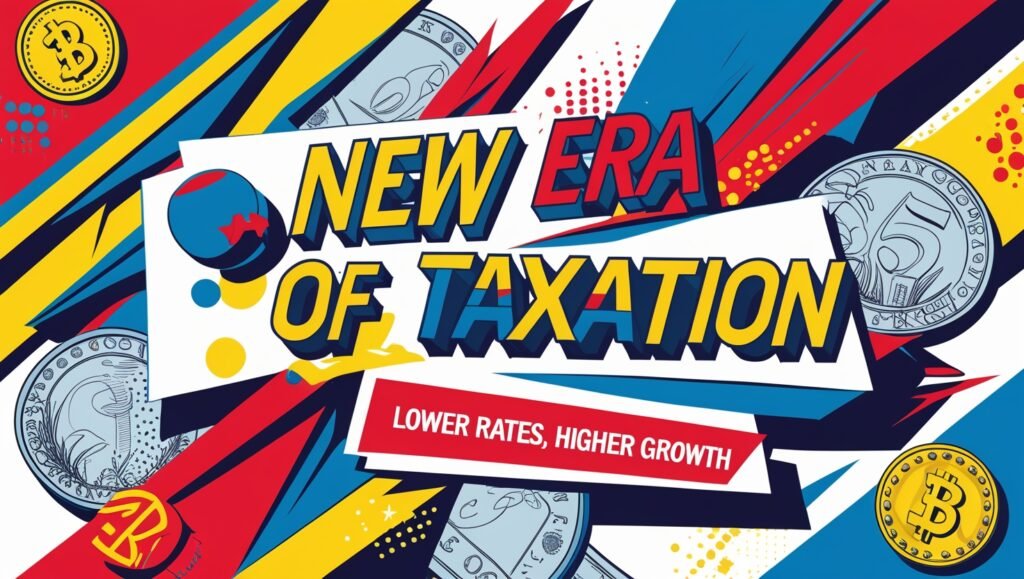Understanding the New Tax Regime 2025: A Complete Guide
The tax landscape is undergoing significant changes in India, with the introduction of the New Tax Regime 2025. This regime aims to simplify the country’s tax system while ensuring greater tax compliance. In this blog post, we will take a deep dive into the New Tax Regime 2025, exploring its features, benefits, and how it differs from the previous tax system. Whether you are an individual taxpayer or a business owner, understanding this regime is crucial for planning your taxes effectively.
What is the New Tax Regime 2025?
The New Tax Regime 2025 is part of the Indian government’s ongoing efforts to streamline tax policies and reduce the tax burden on individuals. Announced in the Union Budget 2025, the new tax structure seeks to provide taxpayers with a simplified and more transparent way of calculating their taxes. The primary objective of this regime is to reduce the complexity of the existing tax system by removing various exemptions and deductions that were previously available under the old tax regime.
The new tax system offers lower tax rates, but with a key difference: it eliminates most tax deductions and exemptions that were previously allowed. In other words, taxpayers under this system will not be able to claim deductions like those for investments under section 80C or deductions for home loan interest. However, the reduced tax rates aim to compensate for the absence of these exemptions.
Key Features of the New Tax Regime 2025
- Lower Tax Slabs: The New Tax Regime 2025 proposes a reduction in income tax rates across various income slabs. This means individuals will have to pay a smaller percentage of their income in taxes compared to the old tax regime. The new tax rates are designed to benefit taxpayers with a wider range of incomes.
- Simplification: One of the biggest advantages of the new tax regime is its simplicity. Taxpayers no longer need to keep track of numerous exemptions, deductions, and rebates, making tax filing more straightforward and less time-consuming.
- No Deductions and Exemptions: Under the New Tax Regime, most of the deductions and exemptions that were available under the old regime are removed. For instance, taxpayers will no longer be able to claim deductions under sections 80C (for investments), 80D (for insurance premiums), and HRA (House Rent Allowance).
- Uniformity Across Taxpayers: The New Tax Regime seeks to create a more equitable system where taxpayers are subject to similar tax rates without the complications of exemptions or deductions. This is expected to promote fairness and reduce the instances of tax evasion or avoidance.
- Flexibility to Choose: Taxpayers are not obligated to switch to the New Tax Regime 2025. They can continue using the old tax regime if they prefer. However, it is essential to assess both regimes to determine which one results in a lower tax liability.
Comparing the New Tax Regime with the Old Tax Regime
The New Tax Regime 2025 has been introduced alongside the old tax regime, allowing individuals to choose between the two. To make an informed decision, taxpayers need to understand how the two regimes compare.
Income Tax Slabs: Under the New Tax Regime, income tax slabs have been simplified. Below is a comparison between the old and new tax rates for individual taxpayers below the age of 60.
| Income Range | Old Tax Regime (2024-25) | New Tax Regime (2025) |
|---|---|---|
| Up to ₹2.5 lakh | Nil | Nil |
| ₹2.5 lakh to ₹5 lakh | 5% | 5% |
| ₹5 lakh to ₹10 lakh | 20% | 10% |
| ₹10 lakh to ₹20 lakh | 30% | 15% |
| Above ₹20 lakh | 30% + cess | 30% + cess |
In the old regime, taxpayers could benefit from various exemptions and deductions, resulting in lower taxable income. However, these deductions and exemptions are removed in the New Tax Regime, meaning taxpayers will face higher taxable income. Nevertheless, the new regime provides lower tax rates across different income slabs, which can offset the loss of deductions for many taxpayers.
Deductions and Exemptions: The key difference between the two regimes lies in the available deductions and exemptions. In the old tax regime, individuals could reduce their taxable income by claiming deductions for investments, medical insurance, and home loans. For example, under section 80C, taxpayers could claim deductions for contributions to Provident Fund (PF), National Savings Certificates (NSC), and other specified investments.
In the New Tax Regime 2025, most of these deductions and exemptions are removed. While this makes the system simpler, it might not be beneficial for individuals who relied heavily on deductions to reduce their tax liability. Therefore, taxpayers who have significant deductions to claim may find the old regime more advantageous.
Benefits of the New Tax Regime 2025
- Simplified Tax Filing: The removal of exemptions and deductions makes the process of filing taxes much easier. Taxpayers no longer need to maintain detailed records of their investments or apply for various deductions. This simplicity reduces the likelihood of errors during tax filing and makes the entire process more transparent.
- Lower Tax Rates for Some Taxpayers: The reduced tax slabs under the new regime mean that many individuals will pay lower taxes, especially those in the middle-income group. For instance, individuals earning between ₹5 lakh and ₹10 lakh will pay only 10% tax under the New Tax Regime, compared to 20% under the old regime.
- Increased Disposable Income: With lower tax rates, individuals will have more disposable income. This is particularly beneficial for those who do not have significant deductions to claim and would benefit from the simplified structure and reduced tax burden.
- Encourages Compliance: The simplified system makes tax compliance easier. With fewer exemptions and deductions to claim, there are fewer chances of mistakes or errors in filing taxes. The new regime may also reduce tax evasion, as there are fewer loopholes to exploit.
Drawbacks of the New Tax Regime 2025
- Loss of Deductions: For individuals who heavily rely on deductions to reduce their taxable income, the New Tax Regime might not be the best option. Those who invest in tax-saving instruments or pay significant premiums for insurance may find that the new system results in a higher overall tax liability.
- Not Suitable for All Taxpayers: The New Tax Regime may not be suitable for everyone. Taxpayers with large families, high medical expenses, or significant home loan interest payments may benefit more from the old tax regime. In such cases, individuals will need to calculate the tax impact of both regimes before making a choice.
Who Should Opt for the New Tax Regime 2025?
The New Tax Regime 2025 is ideal for individuals who:
- Do not have many tax-saving investments.
- Have a simpler financial structure and are looking for a hassle-free tax filing experience.
- Fall into the middle-income group and stand to benefit from the reduced tax rates.
- Do not heavily rely on exemptions and deductions.
For taxpayers with significant tax-saving instruments, the old tax regime may still be the better option. A careful comparison of both systems is necessary to determine which regime will result in lower taxes.
Conclusion
The introduction of the New Tax Regime 2025 marks a significant shift in the Indian taxation system. With its simplified structure and lower tax rates, it offers many benefits, especially for individuals who do not have significant deductions to claim. However, it may not be suitable for everyone, and taxpayers will need to assess their individual financial situations to make an informed decision. Ultimately, the goal of this new tax regime is to reduce the complexity of the tax system while promoting compliance and increasing disposable income for taxpayers.
Choosing between the old and new tax regimes requires careful consideration. Understanding the nuances of each option and calculating the potential tax impact can help individuals make the right decision for their financial goals. The New Tax Regime 2025 represents a step toward modernizing India’s tax structure, making it simpler, fairer, and more transparent for all.
Must read
https://allchemy.me/moringa-powder-how-to-use-benefits-and-disadvantages
https://royfinance.in/stock-market-crash-the-real-reason-what-to-do/



